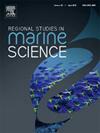抗生素残留在沿海细菌群落抗生素耐药性发展中的作用
IF 2.1
4区 环境科学与生态学
Q3 ECOLOGY
引用次数: 0
摘要
由于废水处理不当、倾倒不当以及农业和其他途径的径流,抗生素正在成为水体中的污染物。污染促进了耐抗生素细菌的生长,危及人类健康和海洋水生生物。水源中的抗生素耐药性已成为一个重大的环境和公共卫生问题。耐药细菌利用水生环境作为蓄水池,由于其收集、扩增和传播耐药细菌的能力,对抗生素耐药性的传播起着重要作用。康巴特湾位于印度西部,是一个重要的海洋生态系统,面临着越来越多的来自工业排放、农业径流和水产养殖废水的抗生素污染。本研究旨在研究海水中抗生素残留的存在及其对细菌耐药性的影响。采用LC-MS检测了6种抗生素(氨苄西林、头孢丙罗西林、头孢他啶、呋喃妥因、诺氟沙星和青霉素G)在多个位点的分布。通过圆盘扩散法和ABCD试剂盒进行的细菌耐药谱分析显示,即使在残留未检测到的区域,也存在广泛的多药耐药,这表明基因水平转移和与污染物的共选择。统计分析将抗生素耐药性与生物需氧量(BOD)、硝酸盐水平和总溶解固体(TDS)升高联系起来,表明污染驱动的选择压力。考虑到墨西哥湾的生态和经济意义,这些发现强调了迫切需要更严格的废水管理和污染控制,以遏制耐抗生素细菌在海洋环境中的传播。本文章由计算机程序翻译,如有差异,请以英文原文为准。
Role of antibiotic residues in development of antibiotic resistance in coastal bacterial communities
Antibiotics are becoming pollutants in water bodies due to inadequate wastewater treatment, inappropriate dumping, and runoff from agriculture and other pathways. The growth of bacteria resistant to antibiotics are promoted through contamination, endangering both human health and marine aquatic life. Antibiotic resistance in water sources has emerged as a significant environmental and public health concern. Antibiotic-resistant bacteria use the aquatic environment as a reservoir, which contributes significantly to the spread of antibiotic resistance due to its ability to collect, amplify, and disseminate resistant bacteria. The Gulf of Khambhat, located in the western part of India, a vital marine ecosystem, faces increasing antibiotic contamination from industrial discharges, agricultural runoff, and aquaculture effluents. This study aims to examine the presence of antibiotic residues and their impact on bacterial resistance in marine waters. Using LC-MS, six antibiotics (Ampicillin, Cefadroxil, Ceftazidime, Nitrofurantoin, Norfloxacin, and Penicillin G) were detected across multiple sites. Bacterial resistance profiling, conducted via the disc diffusion method and the ABCD kit, revealed widespread multidrug resistance, even in areas with undetectable residues, suggesting horizontal gene transfer and co-selection with pollutants. Statistical analysis linked antibiotic resistance with elevated biological oxygen demand (BOD), nitrate levels, and total dissolved solids (TDS), indicating pollution-driven selection pressures. Given the Gulf’s ecological and economic significance, these findings highlight the urgent need for stricter wastewater management and pollution control to curb the spread of antibiotic-resistant bacteria in marine environments.
求助全文
通过发布文献求助,成功后即可免费获取论文全文。
去求助
来源期刊

Regional Studies in Marine Science
Agricultural and Biological Sciences-Ecology, Evolution, Behavior and Systematics
CiteScore
3.90
自引率
4.80%
发文量
336
审稿时长
69 days
期刊介绍:
REGIONAL STUDIES IN MARINE SCIENCE will publish scientifically sound papers on regional aspects of maritime and marine resources in estuaries, coastal zones, continental shelf, the seas and oceans.
 求助内容:
求助内容: 应助结果提醒方式:
应助结果提醒方式:


